Horizontal Navigation Bar w/Rollover Effect
P H O T O G A L L E R Y - Introduction to the natural, intact penis
To fully appreciate the damage caused by circumcision, one must understand how the natural, intact penis should look and function. The photos on this page show the way that Nature/God intended the human penis to look and function.
Exterior Appearance of the Natural Penis (Flaccid)
Just as the female genitalia exhibit a wide variety of appearances of the labia and female foreskin (see the book "Femalia"), so too does the male foreskin reveal a wide variety of length, thickness and coloration. In the adult male, the foreskin accounts for 1/3 to 1/2 of the skin system of the penis, or about 15 square inches of erogenous inner and outer foreskin tissue.
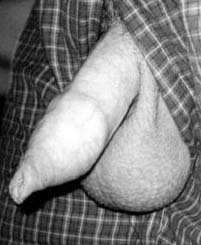
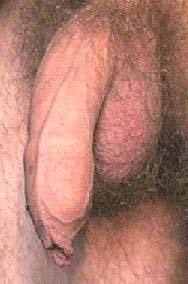
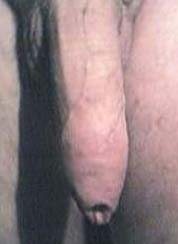

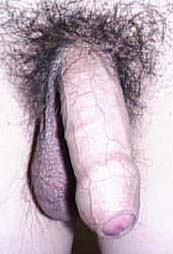
Interior Structures of the Natural Penis
The ridged band, frenulum, and inner and outer foreskin are all destroyed by infant circumcision. The foreskin has 20,000 nerve endings(1) and countless Meissner's Corpuscles - fine touch receptors - similar to those found in the lips, fingertips, female labia, etc. The male glans penis (head) has 4000 nerve endings, and in comparison, the equivalent smaller female clitoris has 8000 such nerve endings. The male foreskin is unquestionably a more highly receptive sensory organ than either the penile head or the female clitoris (or both combined!). Without the full complement of nerve endings and fine touch receptors of the foreskin, some men(2) have said that sex with a circumcised penis is like listening to a symphony without the string section or experiencing sight without colour.
Removal of the male foreskin and the female clitoral hood (female foreskin) are anatomically equivalent.
However, neurologically speaking, removal of the male foreskin is as destructive to male sexual sensory experience as removal of the clitoris is to females. This video discussion of penile and foreskin neurology explains why. It also explains what's behind defensive comments from circumcised men who say 'Oh, I couldn't stand any MORE sensation!' (from minute 11:05 to 15:15). These men are actually referring to the intensely unpleasant sensation in the penile head at orgasm and immediately afterwards, which causes them to not want any further tactile sensation. The foreskin, however, mediates and inhibits unwanted sensory input from the glans, allowing intact men to be in better control of their orgasms.
Contrary to common Western misunderstanding, many circumcised women DO report the ability to feel sexual pleasure and to have orgasm, albeit in a compensatory manner that differs from intact women [suggested reading: Prisoners of Ritual by Hanny Lightfoot-Klein]. Similar compensatory behaviours are used by circumcised men, who can only rely on the remaining 50% (or less) of their penile nerve endings to achieve orgasm.
Just as clitoridectomized girls grow up not knowing the levels of pleasure they could have experienced had they been left intact, so too are men circumcised in infancy unaware of the pleasure they could have experienced had they not had 50% of their penile skin removed at birth. The above video also clarifies what's really behind the erroneous comments of some circumcised men that they 'couldn't stand being any more sensitive'.(1) Logical extrapolation from:
"A piece of skin the size of a quarter contains more than 3 million cells, 12 feet of nerves, 100 sweat glands, 50 nerve endings, and almost 3 feet of blood vessels." (The Human Connection, Ashley Montagu and Floyd Matson, McGraw-Hill, 1979)
"Circumcision removes a piece of skin (that in the adult is) almost equivalent to a 3 x 5 index card." (Say No to Circumcision!: 40 Compelling Reasons, Thomas J. Ritter, MD, and George C. Denniston, MD. Second Edition. Hourglass Book Publishing, 1996) see illustration
The mucosal tissue of the foreskin is highly innervated, more so than normal skin, and 15 quarters will fit on a 3 x 5 index card with room to spare.(2) Men circumcised as adults, or as children and later used foreskin restoration techniques to approximate the look, function and feel of a foreskin.
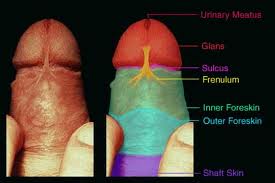
The Frenulum: The Male "F" Spot
While the underside of the upper lip and the tongue each have a frenulum, the penile frenulum connects the foreskin to the underside of the glans, forming what is increasingly known as the frenular delta. Tim Hammond has called this "the male F spot"- comparable in significance to the female G spot - due to its high concentration of nerve endings that react to touch and the rhythmic stretching and relaxation that occurs as the foreskin glides back and forth over the shaft and head of the penis during sexual activity.
The frenulum is usually preserved during an adult circumcision. Due to the imprecise nature of surgery on a small newborn penis, infant circumcision almost always ablates this important sexual structure. Men circumcised in infancy almost universally report that the most erogenous part of their penis is the site of the ablated frenulum where there may still be remnant nerve endings.
Three Zones of Penile Skin
These five photographs show the three zones of skin - dermal tissue of the outer foreskin, the mucocutaneous junction, and the inner mucosal surface of the foreskin - on a normal, intact (non·circumcised) penis as the foreskin is incrementally retracted. Note how the first marked line at the tip of the foreskin (mucocutaneous junction) ends up at the base of the penile shaft when fully retracted. This demonstates the large amount of tissue that the foreskin comprises. PDF version of this illustration. Courtesy J.A. Erickson Collection
Gliding Mechanism of the Foreskin
The foreskin is the ONLY movable part of the penis, as is the intended design of Nature/God. The intact penis with its movable foreskin is a dynamic sexual organ. The circumcised penis has no moving parts and is a static organ.
During sexual activity the nerve-laden inner foreskin, with its erogenous ridged bands, glide up and down the shaft of the penis and over the corona (flared edge) of the glans. The foreskin and glans stimulate each other during this activity. The frenulum is also highly nerve-laden, so every stretch and relaxation of the frenulum produces pleasurable sensations.
Exterior Appearance of the Natural Penis (Erect)
When the penis becomes erect, the foreskin on some men does not retract by itself and the male can choose to manually expose the glans (penile head), as in the three photos on the left.
On other intact men, when the penis erects the foreskin retracts to expose the glans and the male can choose to recover the glans with the foreskin.
Circumcised males do not have these options. There is often insufficient penile skin to accommodate a full erection, which causes many circumcised men to experience tightness and pain during erection. This is revealed in the Gallery of photos submitted by respondents.
Lubricative Qualities of the Foreskin
By now, you've probably noticed the moist appearance of the intact penis. The foreskin preserves the natural male lubricants that keep the internal parts of the penis responsive to sensual pleasures, and aides in its own mobility, as well as reduces chafing and abrasion during sexual intercourse. These lubricative qualities are destroyed by circumcision.
MeatusThe meatus (urinary opening) in the intact penis is usually a long slit that, when compressed by a finger or under pressure of expelling urine, becomes a wide opening. These two photos reveal the differences between a natural meatus and one that is stenosed after circumcision.
Other Functions of the Foreskin
Other functions of the foreskin, which are destroyed by circumcision and which cannot be easily depicted here include:
specialized epithelial Langerhans cells, a component of the (disease-fighting) immune system
the immunological defense system of the soft mucosa, which may produce antibacterial and antiviral proteins such as lysozyme, also found in mothers milk, and plasma cells, which secrete immunoglobulin antibodies.
lymphatic vessels, the loss of which interrupts the lymph flow within a part of the bodys immune system.
apocrine glands of the inner foreskin, which produce pheromones —nature's powerful, silent, invisible behavioral signals to potential sexual partners. They contribute significantly to sexuality. Their loss is unstudied.
estrogen receptors the purpose and value of which are not yet fully understood.
ectopic sebaceous glands, which lubricate and moisturize.
approximately half of the temperature reactive smooth muscle sheath called the dartos fascia.
an estimated 240 feet of microscopic nerves, including branches of the dorsal nerve.
a significant percentage of the distal penis circumference is composed of a double layered fold of inner and outer foreskin, which is missing from the circumcised penis, making the circumcised penis thinner in girth near the head than a full-sized intact penis.
several feet of blood vessels, including the frenular artery and branches of the dorsal artery. The loss of this dense vascularity interrupts normal blood flow to the shaft and glans of the penis, obviously damaging its natural function and possibly stunting its complete and healthy development.
although not yet proved scientifically, there is considerable new evidence that an incomplete penis loses its capacity for the subtle electromagnetic "cross-communication" that occurs only during contact between two mucous membranes, and which contributes to the perception of sexual ecstasy.
Home | Survey | Results | Gallery | Testimony | Custom Reports | Donate | Promote | More Research | Contact
Copyright 2011-2023 Tim Hammond - Global Survey of Circumcision Harm. All Rights Reserved. This site is generously hosted by Intaction, Inc.
.jpg)
